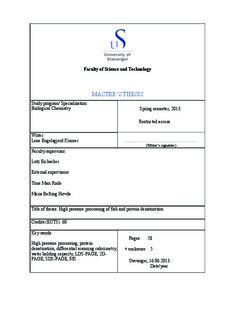| dc.description.abstract | High pressure processing (HPP) is a relative new method for inactivating microorganisms and extend the shelf life of food. This technology has gained increasing attention as an innovative and safe way to process different types of food products. Norwegian salmon is surfing an international popularity wave of sushi, which is now found in retail stores as well as restaurants. Refrigerated storage for a few days is desirable from the producers’ point of view, while the consumers demand a texture, colour and eating quality equal to a fresh fish. Furthermore everyone is concerned about food safety. Can all these demands and desires be satisfied by high pressure processing?
In this thesis, a study of the protein denaturation that takes place during HPP of Atlantic salmon is presented. In addition protein denaturation was investigated for raw turbot and compared to salmon. Salmon was exposed to the pressures: 100, 150, 200, 250, 300, 350, 400, 500, 600 and 685 MPa and the pressure treated samples were compared with unprocessed control samples. To investigate the colour changes during HPP, pictures were taken for colour analysis. The denaturation of proteins in salmon during HPP was studied by differential scanning calorimetry (DSC) and polyacrylamide gel electrophoresis (PAGE). The DSC is a method to characterise the energetics of temperature induced conformational changes in proteins. PAGE separates the proteins according to size in an electric field. In addition, different gel electrophoretic techniques were used like native, combined native and denatured, and finally denatured PAGE. From these techniques more information about the proteins in their biological native form with intact complexes and subunits could be studied. Mass spectrometry (MS) was used to identify the proteins of selected bands from the gels. The result of MS analysis was fragments of peptides, which were identified by protein blasting.
Myosin and actin were the two main proteins investigated. DSC analysis determined the onset of denaturation for myosin between 200-250 MPa, while actin denatured at approximately 300 MPa. Comparing these findings with results from native gel electrophoresis, the loss of protein bands between 480-720 kDa indicated the onset of myosin denaturation starting at 200 MPa while actin was stable at all pressure loads. MS analysis of SDS-PAGE identified myosin heavy chain just below 250 kDa, while myosin light chain, troponin I and troponin C was identified around 20 kDa. Denaturation enthalpies from DSC of raw salmon and turbot were compared, and resulting in the highest myosin denaturation for salmon, while turbot had the highest actin peak. DSC curves of turbot were uneven jagged curves; therefore HPP was not performed on turbot. Post mortem aging of turbot was also investigated by DSC and gel electrophoresis, results showed the myosin denaturation remained stable during cold storage, while actin denatured with a slow rate towards day 24.
The overall conclusions from these investigations were that DSC alone could not provide accurate information about denaturation of proteins by HPP. Native gel electrophoresis should be the preferred method for further denaturation analysis of HPP fish in combination of MS and potentially Western blotting. | no_NO |
